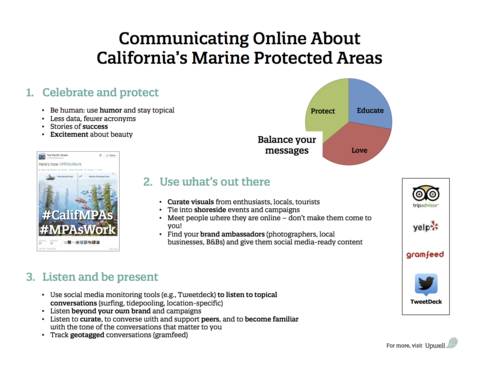Blog Feed
Bittersweet news: Upwell is shutting down.
“It's time to say goodbye, but I think goodbyes are sad and I'd much rather say hello. Hello to a new adventure.” - Ernie Harwell, broadcaster.
Happy New Year to all of you on Team Ocean. We hope your holidays were restful and delicious, and that you’re excited for a 2015 of #oceanoptimism.
It’s hard to believe, but 2015 marks the fourth year of Upwell's existence. The Tide Report first fluttered into your virtual mailboxes in June 2012, and as you can see, it’s evolved a lot since then. We’ve covered a lot of ground: from ocean plastic cleanup schemes to ocean acidification warnings to Gangnam Style (remember when that was a thing?) on the Rainbow Warrior. Plus, of course, there have been plenty of random but necessary pictures of sea otter cuteness:

Yes, exactly like that. And outside of the Tide Report, Upwell has sharkinared and attention lab-ed, and oystered New York, and oh so many things, and none of it would have been possible without all of you, and it’s been wonderful which makes it so difficult to write this next sentence, but here goes.
Upwell will be closing up shop this spring.

Whaaaaaaaaaaat?
We know, we know. We feel the same way. But, while we are sad to deliver this news, we are also filled with hope.
Here’s the honest truth about how and why we’ve made this decision.
After two years of exploring a variety of funding options and models, we’ve been unable to secure dedicated ocean funding that is sufficient to maintain our core ocean programming. In partnership with our major funders, we’ve made the difficult decision to close down our program, with a likely end date of March 31.
We really tried to find a way to sustain Upwell, promise. Upwell has been interesting, fulfilling work for all of us. And it was worth fighting to keep this project alive - up to a point. Now, closing down is the right path for us as individuals and as an organization. While bittersweet, this is the right thing to do.
We were fortunate to be able to do this movement-level work, collaborating with so many organizations, scientists, journalists and passionate activists. We’re grateful to our funders and collaborators, and to our current fiscal sponsor the New Venture Fund, for believing in this work and helping achieve the great many successes we’ve seen since we began our little organization back in 2011. Many took a chance with us, in hopes of creating change and deep impact.
Thank you for your trust. Thank you for the many times you amplified the story that the ocean is in crisis. Thank you for all of your good advice and tips. Thank you for not giving up on the ocean.
We are not done yet.
Our focus for the next couple months will be learning and sharing. Over the past three years we’ve advanced Big Listening - a way to measure and understand conversations at scale - and found ways to amplify great content through networked campaigning in order to increase the attention to the most pressing ocean conservation issues. We’ve been so grateful to work with a community that is not only open to, but excited to learn about this new way of working, and we’ve so enjoyed watching Team Ocean grow.
From Sharkinars to acidification memes to baby seals, we’ve got lessons and memories abound. We want to hear yours too.
Here’s how you can help.
Consider this the beginning of a conversation about how the movement can carry forward this work. Tell us what you’ve learned through working with Upwell, and ask us your burning questions.
We'll be extending invitations to celebrate and learn from this community in a variety of ways over the next couple months - over email, social media, coffee, and video chats. (There may even be some rum involved.) To begin, we’ll be having an “open house” over Twitter tomorrow. Come to us with your questions and ideas, and the team will be standing by to answer.
Tuesday January 13, 11-1 PST/2-4 EST.
Upwell Open House - Participate in the conversation with the hashtag #upwell.
As always, send us your tips (or hopes, fears, missives, manifestos, dreams or ocean gossip) to tips@upwell.us. It goes from you, to all of us.
Onwards,
Rachel, Ray, Matt & The Good Ship Upwell
P.S. The most excellent Upwell team, past and present, has every intention of continuing to work in this (these!) veins. You should hire them, say I, Rachel. They are hilarious and brilliant and brave. Individual contact info here.
Implications for Nonprofits from the Salesforce Marketing Cloud Keynote
This morning I watched the marketing keynote from Salesforce’s Dreamforce conference. What follows is a grab bag of implications for nonprofits, activists and the social impact field in general. Let me know what you think in the comments or @fitz350.
- The corporate world is moving to quickly integrate all marketing channels. While the “customer” experience has been cross-channel for years (think of using your phone to price-check something in a store, or to look up the yelp review of a restaurant you’re standing outside of), marketing data has mostly been siloed. Websites, and now apps, will increasingly deliver content that changes based on your behavior on other channels (email, web, social, even internet-of-things).
- While individualized content has the potential deliver more of what we want, and less of what we don’t, there’s a real benefit to anonymity and the serendipity that results from unplanned interactions with the world.
- We (still, and now more than ever) need strong protections for individual data. Complex algorithms could easily become black boxes of automated discrimination. You should have the right to see (and contest, and remove) the information being stored about you.
- Salesforce is betting heavily on the idea of putting the customer at the center of the experience, of building (or shifting toward) companies that are customer-centric. If you haven’t mapped out the various “journeys” (to use Salesforce speak) that your clients, supporters, donors or constituents go through when they interact with your organization, you’re definitely going to miss opportunities to improve their experience, let alone enhance that experience through individualized support or engagement.
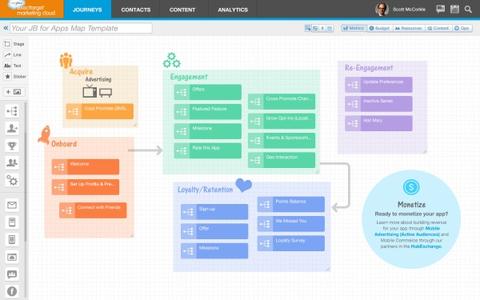
A screenshot of the Journey Builder dashboard in the Salesforce Marketing Cloud.
Each series of events can be triggered by a particular customer or constituent's actions (or lack thereof).
- These “journeys” are the building blocks for customizing campaigns within Salesforce’s marketing platform. Think of the ubiquitous nonprofit donor welcome cycle. For example, you make a donation, you get a thank you email in which you’re asked to signal your interests and then you get a piece of direct mail tailored to your response. Each step of that process can be customized, optimized and analyzed. Did you just hit 10,000 steps for the first time, or recruit your first volunteer? There’s a “journey” designed to take you from that point to converting some business or organizational goal. Smart organizations will remember that your personal goals are the driving force behind your engagement.
- Digital geo-fences are increasingly being deployed to trigger individualized content. In the corporate world this means sending you a coupon on your phone when you walk in the mall, but imagine signing up for a demonstration and having a push notification show up when you get a block away that reminds you to tag your social posts with a particular hashtag, or advises you to take a different route to navigate road blockages. This same function could, of course, be used by a malicious government to identify people who attended or were just in the area of the protest.
- Networked content syndication is upon us. McDonald’s just announced they’ll have all 14,500 stores with their own Facebook page by the end of the year. A video case study explained how the company will use Salesforce’s Marketing Cloud to offer pre-made social content to local stores through a shared archive of posts, made by corporate HQ, that local page managers can choose to edit and publish. The applications for a large NGO with local chapters or affiliates - such as United Way, Y-USA or Sierra Club - are obvious. Potential benefits include freeing up local staff time, pooling resources to create higher quality content, and increased coordination. Potential challenges include over-scheduling of posts (where many campaigns, plus fundraising, are competing for publishing time and audience interaction), a loss of local voice as content gets mass-produced and homogenized, and the risk of increasing the perception that communications are something done by some people or other people in an organization, rather than by everyone (with direction and support from specialized staff).
- Bubbling up the best content from a formal or informal network is still a place where there’s a need for improved tools. CrowdTangle, NewsWhip and (our very own, far more ocean-y and quite different) Tide Report are all examples of how to approach this network or movement-level information flow issue.
The biggest climate thing on Twitter, ever
On Sunday, September 21st I marched with hundreds of thousands of people through the streets of New York as part of the People's Climate March.
Why was I there? Among many other reasons, I was there to march for the ocean.
The turnout was absolutely incredible. As the good folks at Mother Jones put it,
the next time someone tells you that no one gives a sh*t about climate change, show them this picture.

The People's Climate March. Photo by Michael Pollard.
Well I'm here to tell you that the next time someone tells you that your voice doesn't matter on the internet, show them this graph.

What you see there is nearly five years of monthly Twitter data, beginning January 1, 2009 and running through September 30th of this year. The blue line is tweets containing common climate change or global warming terms. The green line is tweets about the People's Climate March.
The huge spike on the right side of the graph tells a simple tale.
The march lifted climate change conversation to its highest level on Twitter, ever.
In September 2014 alone, there were more than half a million tweets about the People's Climate March, and over 6.9 million about climate change or global warming. The climate march posts alone earned a combined 2.8 billion (with a B) potential impressions. While impressions are widely known to be a so-called "vanity metric," in this case I'm just going to sit back and reflect on the size of that number.
Together, we are enormous.
Putting 400,000 people on the streets of New York was impressive enough, but so too is the people's media network that has amplified and energized this movement. Who is that network? It's people like you and me. Together we represent a D.I.Y. media revolution in the form of tweets and posts and status updates that has consistently led - not been led by - the mainstream media. This people's media movement has - through witness, reporting, storytelling and meme-making - increasingly lifted up the voices of frontline and indigenous communities here in the U.S. and around the world, while in the process changing the online conversation about climate change.
When legacy media ignored the climate movement, the climate movement made its own media.
Now that's a legacy to build on.
Onwards!
Team Ocean surfs Shark Week to a 93% increase
Ocean advocates and champions of science won Shark Week this year.
But oh, how the mighty have fallen.... As we explained in an earlier post, Discovery's Shark Week took a massive dive this year, losing nearly half its online conversational volume. This is a big deal for the 27 year-old television and new media empire - the kind that gives rise to groan-inducing headlines about Shark Week (and Discovery) jumping the shark.
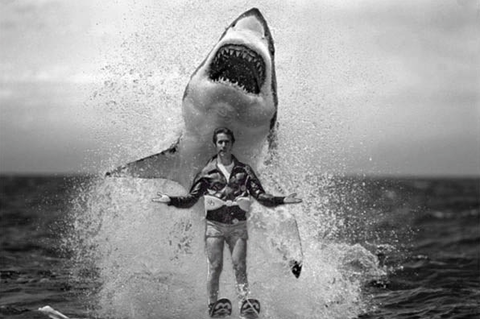
Those who don't know their shark-jumping history are doomed to ill-fated waterski trips.
We here at Upwell pay close attention to Shark Week because it's the Internet's Super Bowl of sharks - or for that matter, anything ocean-related. Each year, across the web, viewers (and bandwagon hoppers) take to social media to share their reactions to the shows and, well, to sharks. Thankfully, most of those people are shark fans.
Because we f@$%in' love sharks, and recognize the danger they're in, for the past three years Upwell has brought the shark conservation community together through our Sharkinars (seriously!) to share tips and make plans to take advantage of the Megalodon-size opportunity that Shark Week presents for bringing new supporters to the cause. (Note: Megalodon, while real, is also extinct, and has been for millions of years).
This year Shark Week followed up its fake 2013 documentary on Megalodon with not one, but two fake documentaries. And on top of that, a host of shows that misrepresented the work of scientists, shared incorrect facts, and inspired fear where fear wasn't due.
Thankfully, Team Ocean stood up and called out Discovery for abandoning their mission to air nonfiction content, and tarnishing the Shark Week legacy that inspired so many young shark scientists and fans. (And, admittedly, probably a lot of dorm-room stoners.)
Shark Week lost 9 million viewers in the process. Nine million. Let that sink in.
This hasn't been a good year for Shark Week but it's been a fantastic one for the shark lovers of Team Ocean. We're here to say thank you.
Even as total Shark Week online conversation took a big hit, shark science and conservation content from Team Ocean experienced a surge of growth.
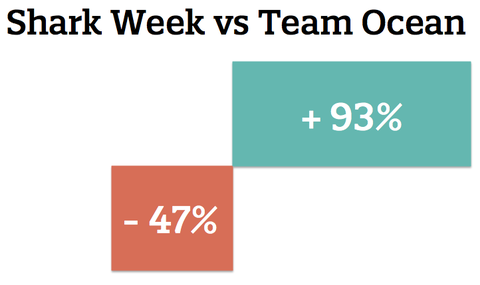
Percent change in online mentions for Upwell's "Shark Week 2014" and "Shark Week: Team Ocean" keyword groups from 2013 levels.
Notice anything? Shark Week lost steam while shark-saving conversation ("Team Ocean") almost doubled. Go team!
Taking a closer look at our collective success reveals a historical trend. This is no flash in the pan.
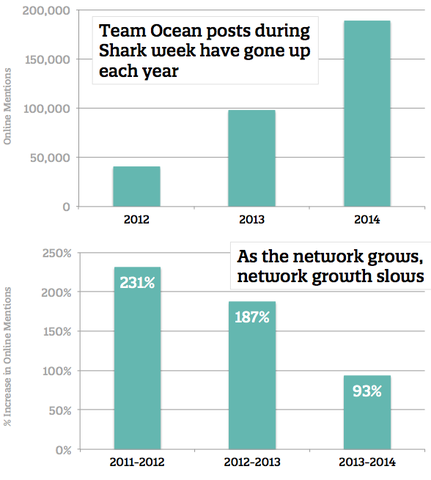
Top: Online mentions for Team Ocean during Shark Week 2012, 2013 and 2014.
Bottom: Year-over-year % Increase in online mentions for Team Ocean during Shark Week, 2012-2014.
What the data reveals is that Team Ocean is growing fast. While that growth may be slowing, that may be due to network saturation. Essentially, more of the team is already in the game.
Furthermore, even among the huge volume of Shark Week posts, the Team Ocean piece of that pie is getting bigger.
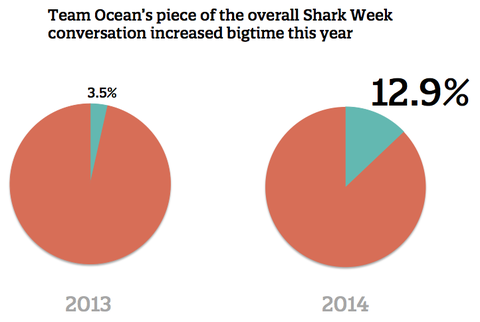
Team Ocean mentions as a percentage of total Shark Week mentions, 2013 vs 2014.
Got that? More pie!
We need more people that care about science and sharks to stand together and continue this momentum in the coming year.
Sharks are cool enough to have their own week, so let's make sure it's as awesome as they are.
Go team!
How to talk about California's marine protected areas online
It’s been 15 years since passage of California’s Marine Life Protection Act, and two years since the completion of California’s new network of 124 underwater parks. Nonprofit organizations in California were critical players in achieving passage of the law and worked steadfastly to design the network in partnership with fishermen, scientists, and recreational ocean users.
This year, Upwell researched how people talk about California's marine protected areas online to learn what drives conversation and understand how to better engage Californians in paying attention to protected ocean resources.
While conversation volume about California's marine protected areas is relatively low, there is a big opportunity to increase attention and impact through creative and targeted communication strategies.
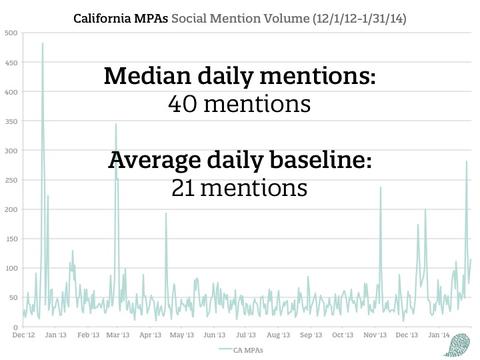
Daily social mentions for Upwell’s California MPAs keyword group (Radian6, 12/1/12-1/31/14).
Our findings show that most conversation about marine protected areas is educational in nature, but the content that drives conversation is celebratory and connects humans to marine resources. Talking about wildlife, explaining how MPAs work, and connecting with recreational and tourist activities helps increase attention.
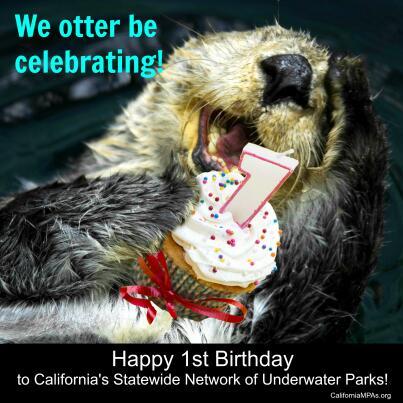
In 2013, there were three reasons the conversation spiked:
- Celebratory events, such as Underwater Parks Day or the birthday of California's MPAs
- News coverage - most often about how MPAs are working
- Meetings and conferences, such as the #MPAsWork Twitter chat in November 2013 and the California Central Coast MLPA Symposium in March 2013
We also learned, through conducting case studies on five specific marine protected areas (Farallon Islands, Anacapa Island, Point Reyes, Elkhorn Slough and Point Lobos) that there is a big opportunity for advocates, ocean managers and educators to tap into local conversations to curate content, find new audiences and connect with local businesses that can serve as brand ambassadors for marine protected areas and marine reserves.
Our recommendations have been compiled into a handy tipsheet for ocean communicators. Click below to download and print!
We held a public webinar on August 7 to present our findings. You can watch the recording or view and download our slides.
Special thanks to the Resources Legacy Fund for their great work in establishing and protecting CA marine protected areas, and for making this research possible.
